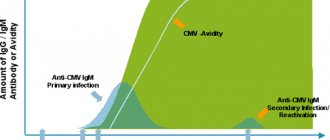The Zimnitsky test allows you to assess the concentration function of the kidneys, i.e. the ability of the kidneys to concentrate and dilute urine. To perform the study, the patient collects urine every 3 hours during the day (8 servings in total). In the laboratory, the amount and relative density of urine in each of the 3-hour portions, daily, daytime and night diuresis are assessed.
Normally, in an adult, fluctuations in the volume of urine in individual portions range from 40 to 300 ml; fluctuations in the relative density of urine between the maximum and minimum values should be at least 0.012–0.016 g/ml. Significant daily fluctuations in relative density are associated with the preserved ability of the kidneys to concentrate or dilute urine depending on the constantly changing needs of the body.
Normal renal concentration function is characterized by the ability to increase the relative density of urine during the day to maximum values (over 1020 g/ml), and normal dilution ability is characterized by the ability to reduce the relative density of urine below the osmotic concentration (osmolarity) of protein-free plasma equal to 1010–1012 g/ml. ml.
Indications for the study
- Signs of kidney failure;
- chronic glomerulonephritis, pyelonephritis;
- hypertonic disease;
- diagnosis of diabetes insipidus.
Conditions for sample collection and storage
Daily urine. Urine for research is collected in separate containers every 3 hours, including at night (8 servings in total).
On the day of the study, excessive fluid intake is not allowed, and diuretics must be avoided.
Defined parameters
- daily diuresis (total amount of urine excreted per day);
- daily diuresis (urine volume from 6 a.m. to 6 p.m. (1–4 servings));
- nocturnal diuresis (urine volume from 6 pm to 6 am (5–8 servings));
- the amount of urine in each of the 3-hour portions;
- relative density of urine in each of the 3-hour portions.
Reference indicators
- increased fluid intake;
- use of osmotic diuretics;
- kidney diseases (chronic renal failure, chronic pyelonephritis, polycystic kidney disease, distal tubular acidosis);
- diabetes insipidus;
- various forms of hypoaldosteronism;
- sarcoidosis, myeloma.
Classification
In clinical practice, it is customary to divide oliguria into 3 large groups:
- Prerenal
. The most common type of oliguria. A drop in diuresis is associated with a deterioration in renal perfusion as a result of bleeding, excessive repeated vomiting, profuse diarrhea, etc. - Renal.
Oliguria is caused by kidney diseases: glomerulonephritis, acute tubular necrosis, interstitial nephritis, etc. - Postrenal.
A small volume of diuresis is associated with obstruction in the urinary tract due to urolithiasis and ureteral stenosis.
Causes of oliguria
Prerenal oliguria
It is the most common type of this pathology. Urine is formed by filtering blood in the kidneys, so any factors that cause decreased renal blood flow can cause oliguria. The mechanisms may be different: a decrease in the level of extracellular fluid, a decrease in the volume of circulating blood (hypovolemia), a drop in total peripheral vascular resistance, or a pronounced narrowing of the lumen of the renal artery.
A decrease in the volume of diuresis occurs acutely; with a severe disruption of the blood supply to the kidneys, a complete absence of urination (anuria) can be achieved. With timely treatment, the vast majority of patients can achieve normalization of diuresis. Prerenal oliguria develops in the following cases:
- Severe fluid losses
: through the gastrointestinal tract (vomiting, diarrhea), through the skin (extensive burns, profuse sweating during hectic fever), massive bleeding. Oliguria can occur with excessive administration of diuretic drugs. - Heart diseases with decreased ejection fraction
: myocardial infarction, congestive heart failure, cardiomyopathies, congenital or acquired heart defects, constrictive pericarditis. - Decreased vascular tone
: sepsis, shock conditions (cardiogenic, traumatic shock). - Renal vascular obstruction:
renal artery stenosis, fibromuscular dysplasia, thrombotic microangiopathies (hemolytic-uremic syndrome, thrombotic thrombocytopenic purpura, disseminated intravascular coagulation).
Oliguria
Renal oliguria
This form is based on lesions of the renal parenchyma, accompanied by a sharp depression of its functional state. This can occur due to primary kidney diseases, kidney damage due to systemic inflammatory pathologies, diseases of other organs, or the entry of nephrotoxic substances into the human body.
The degree of oliguria depends on the severity of the disease. Normalization of diuresis may occur at the beginning of treatment, but in some cases oliguria regresses very slowly, after several months of continuous specific therapy. The causes of renal oliguria are given below:
- Acute or chronic glomerulonephritis.
- Acute pyelonephritis.
- Hydronephrosis.
- Polycystic kidney disease.
- Acute interstitial nephritis.
- Acute tubular necrosis.
- Nephropathy in rheumatic diseases: systemic lupus erythematosus, systemic scleroderma, systemic vasculitis.
- Muscle tissue breakdown: rhabdomyolysis, cardiorenal syndrome.
- Taking nephrotoxic drugs: antibiotics from the group of aminoglycosides (gentamicin, neomycin), non-steroidal anti-inflammatory drugs (analgin, diclofenac), cytostatics (cyclosporine).
- Introduction of X-ray contrast agents.
- Transfusion of incompatible blood according to ABO and Rh system.
- Poisoning with salts of heavy metals: mercury, lead.
Postrenal oliguria
This type of oliguria occurs in case of obstruction of the urinary tract, i.e. when there is a significant obstruction to the flow of urine. It is worth noting that for the development of oliguria, the obstruction must be bilateral, or the patient must have a single kidney. Obstruction of the outflow of urine may be at the level of the ureters, bladder or urethra and can be caused by a calculus, dysfunction of the bladder sphincter, compression by a tumor or an enlarged lymph node.
Also, oliguria can be caused by a neoplasm of an organ located in anatomical proximity to the urinary tract. Oliguria disappears almost immediately after the obstruction in the urinary tract is removed. The most common cause of postrenal oliguria is urolithiasis. Other reasons are listed below:
- Bladder tumor.
- Severe prostatic hypertrophy (adenoma).
- Ureteral strictures.
- Fibrosis of retroperitoneal tissue.
- Lymphoma.
- Stricture of the urethra.
- Abdominal aortic aneurysm.
- Colon cancer.
- Metastases of the lymph nodes of the retroperitoneal space.
- Taking medications that interfere with urination: anticholinergic drugs (atropine).
Treatment
Treatment of oliguria is aimed at stopping the disease of which it is a symptom.
The doctor may prescribe an IV to normalize water and electrolyte balance and dialysis to remove toxins and restore proper kidney function. In case of obstruction of the urethra, a catheter is inserted. It helps release accumulated urine and measure urine production. Nephrotoxic drugs should be avoided as they can worsen kidney disease and slow kidney recovery. These types of medications include contrast agents, aminoglycosides, and nonsteroidal anti-inflammatory drugs. Prescription of medications should be based and adjusted on data on residual renal function.
Hyperkalemia
In practice, the definitive treatment for hyperkalemia with significant oliguria is often dialysis.
Other forms of therapy serve to maintain the normal state of the body. High serum potassium levels should be treated by eliminating all foods containing the mineral and administering the cation exchange resin sodium polystyrene sulfonate (Kayexalate). It will take several hours for the medication to penetrate the mucous membrane of the colon, so the preferred method of administration is rectal. Complications of therapy include hypernatremia and constipation.
If serum potassium levels exceed 6.5 mEq/L, emergency treatment is indicated. In addition to Kayexalate, patients are started on calcium gluconate to reduce the harmful effects of hyperkalemia on the myocardium. At the same time, continuous electrocardiographic monitoring is carried out.
Dialysis
The purpose of dialysis is to remove toxins harmful to the body and maintain water-salt, electrolyte and acid-base balance until kidney function is restored. Indications for dialysis are the severity and duration of the pathology. The procedure is carried out in the following cases:
- a large amount of fluid that does not respond to the use of diuretics;
- acid-base or electrolyte imbalance that does not respond to medications;
- refractory hypertension;
- poisoning of the body with substances that are retained in it during kidney disease.
The choice between hemodialysis, peritoneal dialysis and continuous venous hemodialysis depends on the general clinical condition of the patient, the cause of renal failure, physician preference and possible contraindications.
Diagnostics
To find out the causes of oliguria, you must immediately consult a general practitioner, nephrologist or urologist. The doctor questions the patient in detail about the volume of urination, the presence of other complaints, previously diagnosed chronic pathologies, and the use of medications. The history of the disease is important - it is specified what preceded the appearance of oliguria.
A physical examination is also performed: measuring body temperature, blood pressure, checking Pasternatsky’s symptom, and the presence of peripheral edema. This information helps the specialist to differentiate the etiological factor and correctly direct the diagnostic search. For this purpose, an additional examination is prescribed:
- Blood tests.
In case of infections or autoimmune diseases, a general blood test shows signs of inflammation - leukocytosis and an increase in ESR. In a biochemical blood test, the concentrations of urea, creatinine, potassium, and C-reactive protein were increased. In case of systemic bacterial infections, the blood is tested for the content of presepsin and procalcitonin. The coagulogram often reveals signs of hypercoagulation - shortening of prothrombin time and APTT. - Urine tests.
With renal oliguria, signs of urinary, nephritic or nephrotic syndromes are revealed - proteinuria, hematuria, leukocyturia. To assess the concentration function of the kidneys or the presence of hidden renal pathology, functional tests are prescribed - Zimnitsky, Nechiporenko, Kakovsky-Addis. In the case of severe nephrological disease, microscopy of urine sediment reveals casts (granular, erythrocyte) and renal epithelial cells. - Immunological studies.
If post-streptococcal glomerulonephritis is suspected, the level of antistreptolysin (ASLO) is checked. To confirm rheumatological diseases, tests are prescribed for rheumatic factor and other autoantibodies - antibodies to DNA, to the cytoplasm of neutrophils, to topoisomerase. - Ultrasound.
Ultrasound of the kidneys can show various pathological signs - expansion of the pyelocaliceal system, compaction of the parenchyma, the presence of stones. Echocardiography in CHF shows dilation of the heart chambers, areas of myocardial hypertrophy, and a decrease in ejection fraction. - Urography.
Excretory urography allows you to establish the localization of a mechanical obstruction in the urinary system. Often prescribed to patients with urolithiasis. - Angiography.
Angiography is recommended to assess the patency of the renal arteries. A narrowing of the lumen of more than 50% indicates severe stenosis. - CT.
In case of oncological suspicion, a CT scan of the abdominal cavity and pelvic organs is performed to visualize a neoplasm of the kidneys or retroperitoneal organs. - Histological studies.
To confirm the presence of a malignant tumor, a biopsy is taken followed by pathological examination.
Also, for the differential diagnosis of prerenal and renal oliguria, the following is determined:
- urine osmolarity, incl. urine sodium concentrations;
- ratio of urine osmolarity to blood plasma osmolarity;
- the ratio of urea and creatinine content in urine to their level in plasma;
- partial sodium excretion.
Hemodialysis
Correction
Conservative therapy
Regardless of the cause, a patient with oliguria should be hospitalized in a hospital for treatment of the disease or pathological condition that caused this disorder. In case of kidney damage caused by taking a nephrotoxic drug, it is necessary to immediately discontinue it and replace it with a safer drug. In the hospital the following is carried out:
- Infusion therapy.
In case of prerenal oliguria, in order to replenish fluid deficiency in the body and normalize the blood volume, oral rehydration and parenteral administration of crystalloids (saline, Ringer's solution) are prescribed. To stabilize the acid-base balance, namely, to correct acidosis, the introduction of bicarbonate is recommended. - Fighting shock.
In shock conditions, to improve renal blood flow, it is necessary to use cardiotonic (dobutamine, dopamine) and vasopressor drugs (norepinephrine). - Improving the pumping function of the heart.
With a weak ejection fraction, drugs are used to treat heart failure - beta-blockers (bisoprolol), angiotensin-converting enzyme inhibitors (lisinopril), potassium-sparing diuretics (spironolactone). - Combating rheological disturbances.
For diseases accompanied by thrombus formation, anticoagulants are prescribed - low molecular weight heparin, warfarin, dabigatran. - Fighting infection.
In patients with acute intestinal infection, antibacterial agents from the fluoroquinolone group (levofloxacin) are used. For pyelonephritis, the drugs of choice are penicillin antibiotics (amoxicillin) and cephalosporins (cefexime). - Anti-inflammatory therapy.
In the case of glomerulonephritis or nephropathy in rheumatological pathologies, drugs that suppress autoimmune inflammation are effective - glucocorticosteroids (prednisolone), cytostatics (azathioprine, cyclosporine). - Chemotherapy.
For oncological diseases, courses of chemotherapy drugs are prescribed - alkylating agents, antimetabolites, hormone antagonists. - Extracorporeal detoxification
. Hemodialysis or peritoneal dialysis is indicated to remove excess accumulated end metabolites of nitrogen metabolism from the systemic circulation, as well as to combat hyperkalemia.
Surgery
In case of urolithiasis, the method of stone removal is selected by the surgeon strictly individually for each patient (percutaneous nephrolitholapaxy, laparoscopic or open surgery). Depending on the extent of the lesion in polycystic kidney disease or a kidney tumor, resection or total nephrectomy is performed. In case of bilateral polycystic disease, kidney transplantation is necessary.
Severe prostate hypertrophy is an indication for its removal or resection. In case of ureteral stricture, reconstructive operations are performed - dissection of fibrous adhesions, plastic surgery with intestinal autograft, creation of anastomosis. In cases of severe stenosis of the renal artery, stenting is necessary.
Possible complications
Infections develop in 30-70% of those with oliguria and mainly affect the respiratory and urinary systems.
Poisoning the body with harmful substances and improper use of broad-spectrum antibiotics can contribute to a high level of infectious complications. Cardiovascular disease is the result of fluid and sodium retention in the body. These include hypertension, congestive heart failure, and pulmonary edema. Hyperkalemia leads to electrocardiographic abnormalities and arrhythmias.
Other health problems associated with oliguria:
- Gastrointestinal tract: anorexia, nausea, vomiting and intestinal obstruction.
- Hematological diseases: anemia and platelet dysfunction.
- Neurology: confusion, asterixis, drowsiness and convulsions.
- Infections: weakened immunity and shock.
Other disorders due to electrolyte and acid-base imbalances: metabolic acidosis, hyponatremia, hypocalcemia and hyperphosphatemia.







